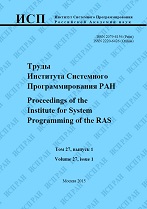|
Generalized context-dependent graph-theoretic model of folklore and literary texts
N. D. Moskin, A. A. Rogov, R. V. Voronov
Petrozavodsk State University
Abstract:
One of the problems of automatic text processing is their attribution. This term is understood as the establishment of the attributes of a text work (determination of authorship, time of creation, place of recording, etc.). The article presents a generalized context-dependent graph-theoretic model designed for the analysis of folklore and literary texts. The minimal structural unit of the model (primitive) is a word. Sets of words are combined into vertices, and the same word can be related to different vertices. Edges and graph substructures reflect the lexical, syntactic and semantic links of the text. The characteristics of the model are its fuzziness, hierarchy and temporality. As examples, a hierarchical graph-theoretical model of components (on the example of literary works by A. S. Pushkin), a temporal graph-theoretic model of a fairy tale plot (on the example of Russian fairy tales by A. M. Afanasyev) and a fuzzy graph-theoretic model of «strong» connections of grammatical classes (on the example of anonymous articles from the pre-revolutionary magazines «Time», «Epoch» and the weekly «Citizen», edited by F. M. Dostoevsky). The model is built in such a way that it can be further explored using artificial intelligence methods (for example, decision trees or neural networks). For this purpose, a format for storing such data was implemented in the information system «Folklore», as well as procedures for entering, editing and analyzing texts and their graph-theoretic models.
Keywords:
graph-theoretic model, text attribution, lexis, syntax, semantics, fuzzy graph, hierarchical graph, temporal graph, information system «Folklore».
Citation:
N. D. Moskin, A. A. Rogov, R. V. Voronov, “Generalized context-dependent graph-theoretic model of folklore and literary texts”, Proceedings of ISP RAS, 34:1 (2022), 73–86
Linking options:
https://www.mathnet.ru/eng/tisp666 https://www.mathnet.ru/eng/tisp/v34/i1/p73
|

| Statistics & downloads: |
| Abstract page: | 14 | | Full-text PDF : | 23 |
|




 Contact us:
Contact us: Terms of Use
Terms of Use
 Registration to the website
Registration to the website Logotypes
Logotypes








 Citation in format
Citation in format 